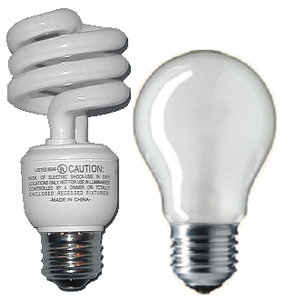 Image via Wikipedia
Image via WikipediaStores Stock New Bulbs for the Light Switch
Energy-Efficient Alternatives to Incandescents Appear in Stores, but Confusion Over Cost and Look; Watts vs. 'Lumens'Turns out, changing a light bulb is harder than it seems.
New bulbs using halogen, compact-fluorescent and LED technologies have been sprouting up on store shelves recently. The flurry of products is a result of legislation passed in 2007 that requires general-purpose bulbs, starting in January, to be at least 25% more efficient than those using standard incandescent technology invented by Thomas Edison in 1879. (click below to read more)
As a result, most of today's incandescent bulbs will be phased out (some specialty bulbs are exempt) by 2014 and replaced by more efficient alternatives. While cheap at 25 to 50 cents a pop, incandescent bulbs waste nearly all their energy in heat output.
Watts Going On?
To meet new efficiency standards, stores and manufacturers are rolling out alternatives to the familiar pear-shaped incandescent light bulb. Below, a comparison of technologies that can substitute in brightness and color for a warm or soft white 60-watt (800 lumen) incandescent bulb.
The light-bulb industry now faces a daunting task of re-educating shoppers who are still in the dark about their choices. A recent survey by General Electric Co. shows three-quarters of consumers have no idea about the new regulation and impending changes.
"They have all these new types of lights, and it's difficult to ascertain the benefits," says Don Hough, a New York City resident who frequently shops for bulbs for his residence and medical education and marketing business. "And the people working in the store, sometimes they don't know either."
Most people are accustomed to buying bulbs based on watts, which refers to energy usage. Soon, they'll buy based on actual brightness, which is measured in something called lumens. That's because manufacturers have figured out a way to produce the same amount of light with fewer watts. For example, a typical halogen-incandescent model today needs only 43 watts to create 800 lumens—the same brightness as a 60-watt incandescent bulb.
"You talk about lumens and the consumer looks at you like you're speaking French to them," says Bill Hamilton, Home Depot Inc.'s electrical merchandising vice president who says stores have seen worried consumers hoarding incandescent bulbs.
To help translate, manufacturer GE this fall will introduce a dramatic packaging overhaul, organizing its light bulbs by lumen level using five different colors—yellow, green, blue, orange and purple. A watt-conversion will be on the package. Other brands, such as Osram Sylvania, will color-code packaging based on the light's actual color (warm and cool). By next year, the Federal Trade Commission will require manufacturers to post "Light Facts" labels on most bulb packaging with info about brightness, light appearance and annual energy cost, among other things.
"It's a very significant shift for us," says Kristin Gibbs, GE's general manager of consumer marketing for lighting. "We've got to manage consumer anxiety through this."
Initially, consumers will find three main alternatives to incandescent bulbs on shelves: halogen-incandescent, compact fluorescent (CFL) and light-emitting diodes (LED). Many are designed similarly to the familiar pear-shaped "A-Line" bulb consumers know. Halogens behave most like existing bulbs, but have an inner capsule filled with halogen gas around a filament to make the bulb about 25% more efficient than a traditional incandescent. They're also the cheapest alternative at less than $2 each.
"It's essentially a souped-up incandescent bulb," says Peter Soares, director of marketing for consumer lighting at Philips Electronics North America.
CFLs, by comparison, produce a 75% energy savings and cost about $2 to $5 each. However, the bulbs contain faint traces of mercury, which can be released as vapor if the bulb is broken until properly cleaned up, according to the Environmental Protection Agency.
The tell-tale "spiral" shape many consumers find unsightly is now often hidden inside a pear-shaped outer bulb. And consumers who complained about the bulbs' blue, sickly hues are finding new CFLs that produce light that is equally warm as incandescent, says Mr. Soares of Philips. "In the end, CFLs may be a bridge technology to get us to some point in the future."
That future, most in the industry believe, is the LED lamp—an ultra-compact light source using a semiconductor chip that is up to 85% more efficient than incandescent and lasts 25 times longer.
LEDs remain the priciest option, with 9-watt and 13-watt bulbs that replace 40-watt and 60-watt incandescent models costing from $20 to $55 each. Despite the price, they're gaining traction, and bulb costs are expected to drop dramatically over the next three years. Sales of LEDs at Home Depot, including the retailer's own "EcoSmart" bulb brand, rose 500% in the last fiscal year ended Jan. 30. "I really believe LEDs will be our light source for every socket in our home in very short order here," says the retailer's Mr. Hamilton.
In coming months, Philips, Home Depot, Osram Sylvania and other major brands will roll out LED substitutes for the 75-watt incandescent bulb, and a spate of 100-watt-equivalent LEDs are expected next year. One start-up, San Jose, Calif.-based Switch Bulb Co., says this fall it will offer an LED substitute for the 100-watter with suggested retail price of about $30.
The U.S. Department of Energy estimates that bulbs compliant with the new law could save U.S. households nearly $6 billion in energy costs in 2015, when rollout is complete. Consumers may also be able to put brighter bulbs in their existing lamps and fixtures because the new bulbs use less wattage.
"Right now people don't think about light bulbs," says Ellen Sizemore, product marketing manager for LED retrofit lamps at Osram Sylvania. "And the industry is going to force them to do that."

No comments:
Post a Comment